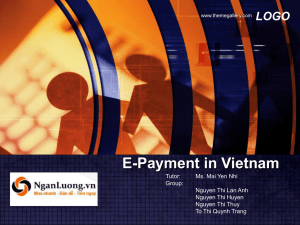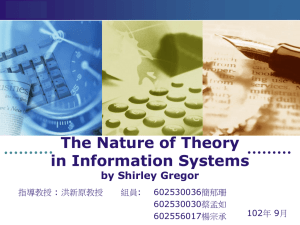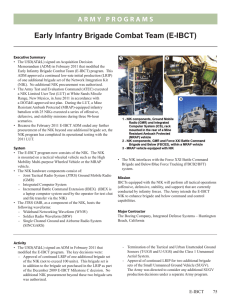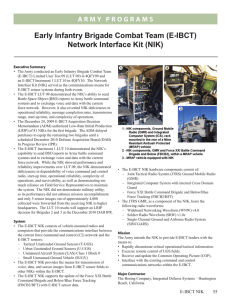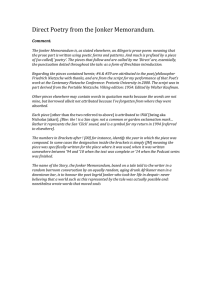Low Power Systems
advertisement
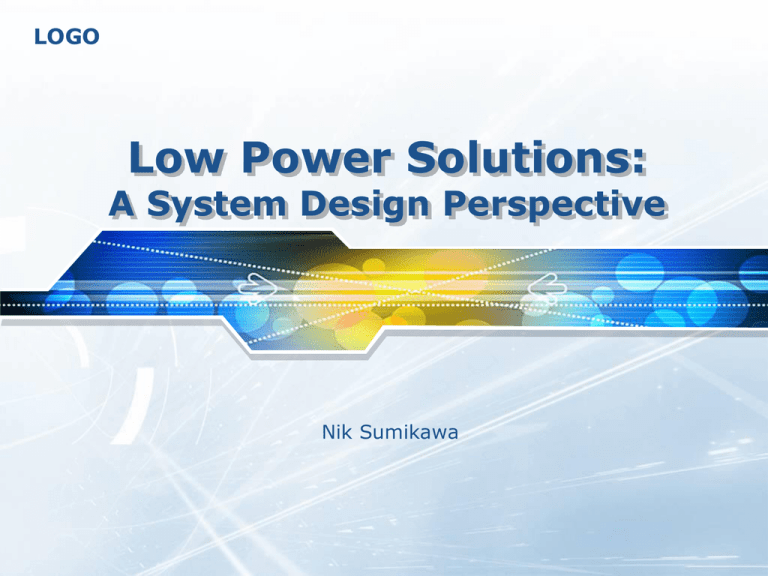
LOGO Low Power Solutions: A System Design Perspective Nik Sumikawa Nik Sumikawa Contents 1 Low Power: Why? 2 Standard Embedded Solutions 3 Innovative Solutions 4 Solutions for Mobile Platforms www.themegallery.com Low Power: Why? Power vs. Performance Technology Scaling VLSI Embedded Technology Trend Green Stimulus Scaling Size Company Logo www.themegallery.com What You Should Think About Low power design strategies Components: Microcontrollers, peripherals, ect. Low power design with hardware Low power design with software Low power design in mobile device Company Logo www.themegallery.com Low Power Embedded Systems TELOS: Low power wireless embedded system Low duty cycle principle Minimizes dynamic power consumption Company Logo Nik Sumikawa Low Duty Cycle Principle Timer or Interrupt event Process Wake Up Sleep Mode Deep Sleep Sleep Prep Nik Sumikawa Low Duty Cycle Low processing to sleep ratio Extended sleep period Responsively: fast wake-up and sleep times Minimize Interrupts: Context switching overhead Company Logo Nik Sumikawa Low Duty Cycle: DMA Direct Memory Access (DMA): Controls bus and transfers data with minimal processor overhead Significance Transfer data while sleeping Minimize processor overhead Company Logo Nik Sumikawa Low Duty Cycle Fails with significant processing Alternatives: Dynamic Voltage and Frequency Scaling (DVFS) Dynamic Power Management (DPM) Image: http://www.domainmagnate.com/wpcontent/uploads/2009/03/failure-success.jpg Nik Sumikawa Dynamic Power Design Variables Energy Source Capacitance Frequency Dynamic Power Voltage P = CVdd2f Battery www.themegallery.com Reducing Dynamic Power Dynamic Voltage and Frequency Scaling Scale voltage when sleeping/Idle Voltage term quad. proportional to power Reduce frequency Minimize line capacitance Long traces have large capacitance Company Logo www.themegallery.com Dynamic Power Management Generalize power management Multiple policies Single-policy Multiple-policy Task-scaling Rajami and Brock [2] Nik Sumikawa Single-policy Strategy Idle Scaling (IS) Operate at full speed when processing workload Reduce the frequency and voltage when idle Goal: Reduce the CPU and bus frequencies Meet continuous DMA requirements Provide acceptable latency when resuming from idle Rajami and Brock [2] Nik Sumikawa Multi-policy Strategies Load scaling (LS): Balance system operating point with current or predicted processing demands Run system with minimal idle time Other: Manage systems state based on status of the systems energy source Rajami and Brock [2] Nik Sumikawa Task-scaling Strategies Application scaling (AS): Used for workloads that are difficult to power manage • Audio and video processing • Begin processing next sample immediately Operate a lower operating point Increases to higher operating point when it begins to fall behind. Rajami and Brock [2] Nik Sumikawa Results of DPM IS: Idle Scaling LS: Load Scaling AS: Application Scaling Frame-Scaling (FS): perfect knowledge of processing requirements of video frame Rajami and Brock [2] Nik Sumikawa Too Many Low Power States Disadvantages: Confusion Wrong low power state Solution: Minimize the number of state Decrease complexity Image: http://kunaljanu.files.wordpress.com/2009/02/ ist2_1457667confusion-1.jpg Nik Sumikawa Sources of Power Consumption Microcontroller Bus architecture On chip communication External communication Memory hierarchy Peripherals Rajami and Brock [2] Nik Sumikawa Communication Architectures Advanced Microcontroller Bus Architecture ARM bus protocol for system-on-a-chip (SOC) Advanced High Performance Bus (AHB) • Pipelined • Memory mapped • Up to 16 masters, 16 slaves Advanced Peripheral Bus (APB) • Non pipelined • Single master, up to 16 peripherals Rajami and Brock [2] Nik Sumikawa AMBA On-chip Bus Rajami and Brock [2] Nik Sumikawa Power Profiling 86% power consumed by logic 14% power consumed by bus lines Rajami and Brock [2] Nik Sumikawa Power Reduction Techniques Power Management Shut down bus interfaces to idle slaves Bus Encoding Reduces # of line transitions, but not bus transactions Traffic Sequencing Reduce multiple masters interleaving bus access Rajami and Brock [2] Nik Sumikawa Power Reduction Techniques No technique achieves large saving alone Rajami and Brock [2] Nik Sumikawa Power vs Energy Power is amount of energy over an amount of time (Watts = Joules / second) Battery provides finite amount of energy Goal: minimize energy use, not just power In mobile systems we care about energy Budget energy to prolong battery life Rajami and Brock [2] Nik Sumikawa Static System Optimization Compiler techniques Instruction energy consumption profiling • Done empirically Instruction reordering • • • • Without affecting correctness Improve register utilization Reduce memory accesses Reduce pipeline stalls Nik Sumikawa Static System Optimization Code Compression Post compilation static optimization Reduces storage size of instructions Can have a large impact Requires complex design space exploration Goal for mobile system: reduce power consumption while preserving performance Nik Sumikawa Code Compression Challenges Random access decompression Defining decodable block beginnings Jump to new locations in program without decoding all blocks between Solutions Begin compressed blocks on byte boundaries Store translation table • More efficient the compression, larger the table Recalculate branch offsets to compressed addresses Nik Sumikawa Code Compression Requirements Additional hardware Additional memory to store table Decompression unit Design decisions Table generation/lookup Compression technique Nik Sumikawa Code Compression Implementation SPARC ISA Optimize consumption of complete SOC Multiple iterations on binary Instructions split into 4 categories Group 1: immediate instructions (code = 0) Group 2: branch instructions (code = 11) Group 3: dictionary instructions (code = 100) Group 4: uncompressed instr (code = 101) www.themegallery.com Diagram Update branch offsets Optimized Binary Phase 4 Branch compression Phase 3 Immediate compression Phase 2 Markov model Compiled Binary Phase 1 Company Logo Nik Sumikawa As a Result… Bus Compaction Instructions transmitted no longer require entire bus Use the extra lines to transmit the next compressed instruction Nik Sumikawa Decompression Architecture Pre-Cache Decompression engine between memory/cache Post-Cache Decompression engine between cache/cpu Nik Sumikawa Simulation Full SOC simulation 7 sample apps run Nik Sumikawa Results Nik Sumikawa INCLUDE? Nik Sumikawa Results Net energy saving observed 22-82% power savings from code compression What about additional hardware? Bonus Increased performance Reduced area Nik Sumikawa Verdict Static power optimization Potentially large payoff for little preprocessing Still more sources of consumption We’ve observed SOC savings What about peripherals? Nik Sumikawa Energy Budget Voice Call SMS Energy Budget Emails Pictures localization Nik Sumikawa Energy Budget: Localization How much of the energy budget should be given to localization? Depends on the user Grant increase allotment when localization is a higher priority Nik Sumikawa Localizations Methods 1 2 3 GPS GSM WiFi • Very accurate • Power Hungry • Lower accuracy • Lower power requirement • Mod. Accurate • Mod. Power requirement Nik Sumikawa Power vs. Precision Localization Power: Precision: amount of energy required by peripheral in order to determine location Accuracy of the device used for localization Constandache, Gaonkar, Sayler, Choudhury, Cox [3] www.themegallery.com Power Consumption 30 Second sampling intervals Power Consumption: GPS: High baseline WiFi: Low baseline with high spikes GSM: Low baseline with varying spikes Constandache, Gaonkar, Sayler, Choudhury, Cox [3] www.themegallery.com Power Consumption 30 Second sampling intervals Results: GPS: increased baseline Company Logo www.themegallery.com Localization Accuracy Accuracy varied based on location ALE: Average Location Error Wifi and GSM oversampled Company Logo www.themegallery.com Diagram Add Your Text Add Your Text Add Your Text Add Your Text Add Your Text Add Your Text Add Your Text Add Your Text Company Logo www.themegallery.com Diagram Add Your Text Add Your Text Add Your Text Company Logo www.themegallery.com Diagram Add Your Title Add Your Title Add Your Title ThemeGallery is a Design Digital Content & Contents mall developed by Guild Design Inc. ThemeGallery is a Design Digital Content & Contents mall developed by Guild Design Inc. ThemeGallery is a Design Digital Content & Contents mall developed by Guild Design Inc. Company Logo www.themegallery.com Diagram Text Text Add Your Title Text Text Company Logo www.themegallery.com Cycle Diagram Add Your Text B Microcontroller A C Add Your Text Sources Add Your Text E D Add Your Text Company Logo www.themegallery.com Diagram 2001 2002 2003 2004 Company Logo www.themegallery.com Progress Diagram Phase 1 Phase 2 Phase 3 Company Logo www.themegallery.com Diagram Company History 2004 2001 2003 2004.01 Add Your Text 2004.03 Add Your Text 2004.05 Add Your Text 2001.10 Add Your Text 2001.10 Add Your Text 2001.10 Add Your Text 2002 2003.10 Add Your Text 2003.10 Add Your Text 2003.10 Add Your Text 2002.10 Add Your Text 2002.10 Add Your Text 2002.10 Add Your Text Company Logo www.themegallery.com Map Company Logo www.themegallery.com 3-D Pie Chart Text2 Text3 Text1 Text4 Text5 Company Logo www.themegallery.com Block Diagram Add Your Text Add Your Text concept Concept Concept Concept Company Logo LOGO www.themegallery.com


